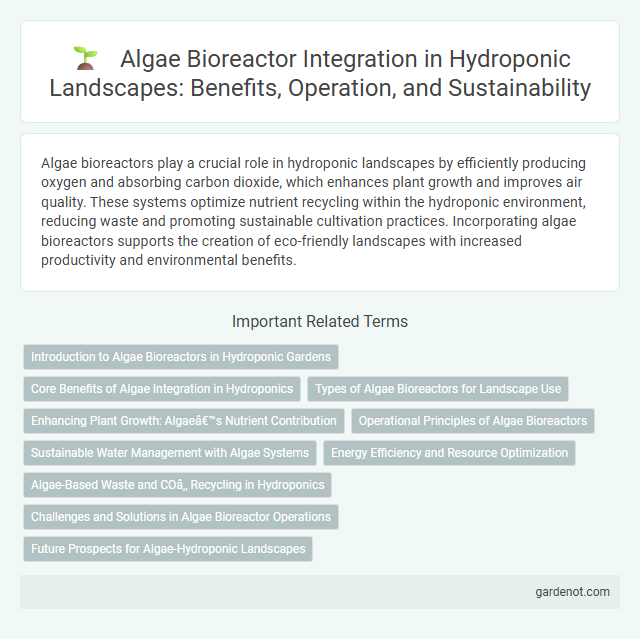Algae bioreactors play a crucial role in hydroponic landscapes by efficiently producing oxygen and absorbing carbon dioxide, which enhances plant growth and improves air quality. These systems optimize nutrient recycling within the hydroponic environment, reducing waste and promoting sustainable cultivation practices. Incorporating algae bioreactors supports the creation of eco-friendly landscapes with increased productivity and environmental benefits.
Introduction to Algae Bioreactors in Hydroponic Gardens
Algae bioreactors in hydroponic gardens serve as sustainable systems that cultivate microalgae to enhance nutrient cycling and water quality. These closed or semi-closed vessels optimize light exposure, CO2 concentration, and mixing to maximize algal biomass production, which can be harnessed for biofertilizers or natural pest control. Integration of algae bioreactors improves overall ecosystem balance, reduces dependency on chemical inputs, and supports efficient resource utilization in hydroponic landscapes.
Core Benefits of Algae Integration in Hydroponics
Algae bioreactors enhance hydroponic systems by improving nutrient cycling and oxygenation, leading to faster plant growth and increased yield. The integration of algae provides natural biofertilizers, reducing the need for synthetic inputs and promoting sustainable cultivation. Additionally, algae contribute to water purification within the system, maintaining optimal water quality and overall plant health.
Types of Algae Bioreactors for Landscape Use
Algae bioreactors for hydroponic landscapes primarily include open pond, tubular, flat-panel, and column types, each optimized for specific environmental and spatial conditions. Open pond bioreactors are cost-effective and suitable for large-scale outdoor applications, while tubular and flat-panel designs provide higher surface area and controlled conditions for enhanced algae growth in smaller or indoor settings. Column bioreactors offer efficient gas exchange and mixing, making them ideal for vertical hydroponic systems integrating algae production with landscape aesthetics.
Enhancing Plant Growth: Algae’s Nutrient Contribution
Algae bioreactors significantly enhance plant growth in hydroponic landscapes by supplying essential nutrients such as nitrogen, phosphorus, and trace minerals through bioavailable organic compounds. The photosynthetic activity of algae produces oxygen, improving root respiration and promoting healthier plant development. Incorporating algae bioreactors into hydroponic systems boosts nutrient cycling and supports sustainable growth with reduced reliance on synthetic fertilizers.
Operational Principles of Algae Bioreactors
Algae bioreactors operate by providing controlled environments that optimize light, temperature, and nutrient supply to maximize algal growth in hydroponic landscapes. These systems typically use photobioreactors designed to enhance photosynthesis efficiency through precise regulation of CO2 levels and mixing mechanisms. Continuous monitoring of parameters such as pH, dissolved oxygen, and biomass concentration ensures optimal productivity and sustainability of algae cultivation.
Sustainable Water Management with Algae Systems
Algae bioreactors in hydroponic landscaping optimize sustainable water management by efficiently recycling nutrient-rich water and reducing wastewater discharge. These systems harness algae's natural ability to absorb excess nutrients and purify water, enhancing water reuse and lowering overall consumption. Integrating algae bioreactors promotes eco-friendly hydroponic practices by minimizing resource waste and supporting closed-loop nutrient cycles.
Energy Efficiency and Resource Optimization
Algae bioreactors in hydroponic landscapes enhance energy efficiency by utilizing low-energy LED lighting and optimizing light distribution for maximum photosynthetic activity. These systems promote resource optimization through closed-loop water recycling and nutrient reuse, reducing waste and operational costs. Integration with hydroponic setups enables simultaneous carbon dioxide absorption and oxygen production, improving environmental sustainability.
Algae-Based Waste and CO₂ Recycling in Hydroponics
Algae bioreactors play a crucial role in hydroponic systems by efficiently recycling waste nutrients and capturing CO2 for enhanced plant growth. These bioreactors utilize algae to convert organic waste into valuable biomass while simultaneously reducing carbon dioxide levels, improving water quality and nutrient availability in hydroponic solutions. Integrating algae-based waste and CO2 recycling technology promotes sustainable hydroponic landscapes by optimizing resource use and reducing environmental impact.
Challenges and Solutions in Algae Bioreactor Operations
Algae bioreactor operations in hydroponic landscapes face challenges such as light penetration limitations, nutrient imbalances, and contamination risks from unwanted microorganisms. Optimizing reactor design with advanced mixing systems and controlled light exposure enhances algae growth efficiency, while implementing sterilization protocols and real-time monitoring mitigates contamination issues. Utilizing automated nutrient delivery and waste removal systems supports stable algae cultures, improving biomass yield and overall system sustainability.
Future Prospects for Algae-Hydroponic Landscapes
Algae bioreactors integrated into hydroponic landscapes present promising future prospects by enhancing nutrient recycling and carbon sequestration, leading to more sustainable urban farming systems. Advances in photobioreactor design and genetic engineering are expected to increase algae biomass yield, improving overall ecosystem productivity and water purification. The synergy between algae cultivation and hydroponics could significantly reduce resource consumption while promoting resilient, eco-friendly landscapes.
Algae bioreactor Infographic

 gardenot.com
gardenot.com